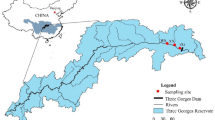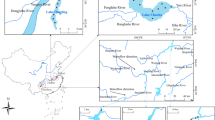Abstract
Iron is a restrictive element for primary productivity in the oceans. The influence of dissolved organic matters as metal chelators on the bio-available iron input to the ocean has been widely reported. However, natural dissolved organic matters, especially the phenolics originated from peatlands and geochemical interactions with iron remains poorly understood. In this study, solid phase extraction-high performance liquid chromatography experiments were conducted to determine the vertical distributions of phenolic acids in different peat layers in Hani Peatland, China. Ten phenolic acids, including protocatechuic acid, p-hydroxybenzoic acid, gentisic acid, caffeic acid, etc. were detected. Simulation experiments of phenolics-Fe interactions under alkaline conditions (pH = 8.0 ± 0.1) indicated phenolic acids bearing either catechol or galloyl groups (such as protocatechuic acid, caffeic acid and gallic acid) could chelate iron to produce relatively stable phenolics-Fe complexes and therefore help to weaken its precipitation in the oxidative condition. In addition, the simulation experiments with artificial coastal waters demonstrated that this complexation could ensure that at least 25 % of the initial Fe load dissolve in coastal water, implying large part of dissolved iron in rivers draining from peatlands could be transported through the estuarine zones. Considering the wide distribution of peatlands globally, the higher concentration of Fe in peatlands, and the enhancement of marine organisms by Fe, the geochemical interactions between iron and phenolics originated from peatlands are of important significance to transport bio-available iron from terrestrial system to oceans.








Similar content being viewed by others
References
Achilles KM, Church TM, Wilhelm SW, Luther GW, Hutchins DA (2003) Bioavailability of iron to Trichodesmium colonies in the western subtropical Atlantic Ocean. Limnol Oceanogr 48(6):2250–2255. doi:10.4319/lo.2003.48.6.2250
Andjelković M, Van Camp J, De Meulenaer B et al (2006) Iron-chelation properties of phenolic acids bearing catechol and galloyl groups. Food Chem 98(1):23–31. doi:10.1016/j.foodchem.2005.05.044
Boyd PW, Jickells T, Law CS et al (2007) Mesoscale iron enrichment experiments 1993–2005: synthesis and future directions. Science 315(5812):612–617. doi:10.1126/science.1131669
Dai M-H, Martin J-M (1995) First data on trace metal level and behaviour in two major Arctic river-estuarine systems (Ob and Yenisey) and in the adjacent Kara Sea, Russia. Earth Planet Sci Lett 131:127–141
Djurdjevi L, Dini A, Mitrovi M, Pavlovi P, Teaevi V (2003) Phenolic acids distribution in a peat of the relict community with Serbian spruce in the Tara Mt. forest reserve (Serbia). Eur J Soil Biol 39:97–103. doi:10.1016/s1164-5563(03)00015-3
Falkowski P et al (2000) The global carbon cycle: a test of our knowledge of earth as a system. Science 290:291–296
Figuères G, Martin JM, Meybeck M (1978) Iron behaviour in the Zaire estuary. Neth J Sea Res 12:329–337. doi:10.1016/0077-7579(78)90035-2
Forsgren G, Jansson M, Nilsson P (1996) Aggregation and sedimentation of iron, phosphorus and organic carbon in experimental mixtures of freshwater and estuarine water. Estuar Coast Shelf Sci 43:259–268. doi:10.1006/ecss.1996.0068
Friedman M, Jürgens HS (2000) Effect of pH on the stability of plant phenolic compounds. J Agric Food Chem. doi:10.1021/jf990489j
Gajewski K, Viau A, Sawada M et al (2001) Sphagnum peatland distribution in North America and Eurasia during the past 21,000 years. Global Biogeochemical Cycles 15(2):297–310. doi:10.1029/2000GB001286
Graham TL (1991) Flavonoid and isoflavonoid distribution in developing soybean seedling tissues and in seed and root exudates. Plant Physiol 95:594–603
Harwood CS, Parales RE (1996) The 2-ketoadipate pathway and the biology of self-identity. Annu Rev Microbiol 50:553–590
Hider R, Liu Z, Khodr HH (2001) Metal chelation of polyphenols. Elsevier Academic Press Inc, San Diego, pp 190–203
Huang T, Cheng SG, Mao XM (2013) Humification degree of peat and its implications for holocene climate change in hani peatland, northeast china. Chin J Geochem 32(4):406–412. doi:10.1007/s11631-013-0649-8
Khokhar S, Owusu Apenten RK (2003) Iron binding characteristics of phenolic compounds: Some tentative structure-activity relations. Food Chemistry 81(1):133–140. doi:10.1016/S0308-8146(02)00394-1
Krachler R, Jirsa F, Ayromlou S (2005) Factors influencing the dissolved iron input by river water to the open ocean. Biogeosciences 2:311–315. doi:10.5194/bg-2-311-2005
Krachler R et al (2010) Relevance of peat-draining rivers for the riverine input of dissolved iron into the ocean. Sci Total Environ 408:2402–2408. doi:10.1016/j.scitotenv.2010.02.018
Kracheler R et al (2015) River-derived humic substances as iron chelators in seawater. Mar Chem 174:85–93
Martin JH (1990) Glacial-interglacial CO2 change: the iron hypothesis. Paleoceanography 5:1–13. doi:10.1029/PA005i001p00001
Martin JH, Fitzwater SE (1988) Iron deficiency limits phytoplankton growth in the north–east Pacific subarctic. Nature 331:341–343
Martin JH, Gordon RM, Fitzwater SE (1990) Iron in Antarctic waters. Nature 345:156–158
Martin JH, Gordon RM, Fitzwater SE (1991) The case for iron. Limnol Oceanogr 36:1793–1802. doi:10.1126/science.283.5403.757i
Matsunaga K, Nishioka J, Kuma K, Toya K, Suzuki Y (1998) Riverine input of bioavailable iron supporting phytoplankton growth in Kesennuma Bay(Japan). Water Res 32:3436–3442
Mayer LM (1982) Aggregation of colloidal iron during estuarine mixing: kinetics, mechanism, and seasonality. Geochimica Et Cosmochimica Acta 46(12):2527–2535. doi:10.1016/0016-7037(82)90375-1
Moore RM, Burton JD, Williams PL, Young ML (1979) The behaviour of dissolved organic material, iron and manganese in estuarine mixing. Geochim Cosmochim Acta 43:919–926
Naumova GV, Tomson AE, Zhmakova NA, Makarova NL, Ovchinnikova TF (2013) Phenolic compounds of sphagnum peat. Solid Fuel Chem 47:22–26. doi:10.3103/s0361521912060092
Pannala AS, Chan TS, O’Brien PJ, Rice-Evans CA (2001) Flavonoid B-ring chemistry and antioxidant activity: fast reaction kinetics 282(5)
Philben M, Kaiser K, Benner R (2014) Biochemical evidence for minimal vegetation change in peatlands of the West Siberian Lowland during the medieval climate anomaly and little ice age. J Geophys Res Biogeosci 119(808–825):2014. doi:10.1002/2013jg002396
Poulton SW, Raiswell R (2005) Chemical and physical characteristics of iron oxides in riverine and glacial meltwater sediments. Chem Geol 218(3):203–221. doi: 10.1016/j.chemgeo.2005.01.007
Powell RT, Landing WM, Bauer JE (1996) Colloidal trace metals, organic carbon and nitrogen in a southeastern US estuary. Mar Chem 55:165–176. doi:10.1016/s0304-4203(96)00054-0
Powell RT, Wilson-Finelli A (2003) Importance of organic Fe complexing ligands in the Mississippi River plume. Estuar Coast Shelf Sci 58:757–763. doi:10.1016/s0272-7714(03)00182-3
Raiswell R (2006) Towards a global highly reactive iron cycle. J Geochem Explor 88(1):436–439. doi:10.1016/j.gexplo.2005.08.098
Rice-Evans CA, Miller NJ, Paganga G (1996) Structure-antioxidant activity relationships of flavonoids and phenolic acids. Free Radic Biol Med 20:933–956
Rice-Evans CA, Miller NJ, Paganga G (1997) antioxidant properties of phenolic compounds. Trends Plant Sci 2:152–159
Rose AL, Waite TD (2003) Kinetics of iron complexation by dissolved natural organic matter in coastal waters. Mar Chem 84:85–103. doi:10.1016/s0304-4203(03)00113-0
Rubin M, Berman-Frank I, Shaked Y (2011) Dust- and mineral-iron utilization by the marine dinitrogen-fixer Trichodesmium 4(8)
Saitoh Y et al (2008) Processes influencing iron distribution in the coastal waters of the Tsugaru Strait. Jpn J Oceanogr 64:815–830. doi:10.1007/s10872-008-0068-3
Salah N, Miller NJ, Paganga G, Tijburg L, Bolwell GP, Riceevans C (1995) Polyphenolic flavanols as scavengers of aqueous phase radicals and as chain-breaking antioxidants 322(2)
Shi Z et al (2012) Impacts on iron solubility in the mineral dust by processes in the source region and the atmosphere: a review. Aeolian Res 5:21–42. doi:10.1016/j.aeolia.2012.03.001
Silva MM, Santos MR, Caroço G, Rocha R, Justino G, Mira L (2002) Structure-antioxidant activity relationships of flavonoids: a re-examination. Free Radic Res 36:1219–1227
Singleton VL, Orthofer R, Lamuela-Raventos RM (1999) Analysis of total phenols and other oxidation substrates and antioxidants by means of folin-ciocalteu reagent. Methods Enzymol:152–178
Tarnawski M, Depta K, Grejciun D, Szelepin B (2006) HPLC determination of phenolic acids and antioxidant activity in concentrated peat extract a natural immunomodulator. J Pharm Biomed Anal 41:182–188. doi:10.1016/j.jpba.2005.11.012
Theis TL, Singer PC (1974) Complexation of iron(ll) by organic matter and its effect on iron(ll). Oxygenation 8(6)
Tsutsuki K, Kondo R (1995) Lignin-derived phenolic compounds in different types of peat profiles in Hokkaido. Jpn Soil Sci Plant Nutr 41:515–527. doi:10.1080/00380768.1995.10419613
Turner SM, Nightingale PD, Spokes LJ (1996) Increased dimethyl sulphide concentrations in sea water from in situ iron enrichment. Nature [H.W. Wilson - GS] 383:513–517
Visser F, Gerringa L, Timmermans KR (2003) The role of the reactivity and content of iron of aerosol dust on growth rates of two Antarctic diatom species1. J Phycol 39:1085–1094
Wan X, Xiang W, Yu S (2013a) Determination of phenols from peatland water by solid phase extraction and high performance liquid chromatography. Chin J Anal Lab 32:15–19. doi:10.13595/j.cnki.issn1000-0720.2013.0259
Wan X, Xiang W, Yu W, Mengqiang D, Hanqin W, Yu S, Chao Z (2013b) Causes of high concentration dissolved iron in plateau peatland. Environ Sci Technol 11:002
Wen L-S, Santschi P, Gill G, Paternostro C (1999) Estuarine trace metal distributions in Galveston Bay: importance of colloidal forms in the speciation of the dissolved phase. Mar Chem 63:185–212
White RA, Freeman C, Kang H (2011) Plant-derived phenolic compounds impair the remediation of acid mine drainage using treatment wetlands. Ecol Eng 37:172–175. doi:10.1016/j.ecoleng.2010.08.008
Williams CJ, Yavitt JB, Wieder RK, Cleavitt NL (1998) Cupric oxide oxidation products of northern peat and peat-forming plants. Can J Bot 76:51–62. doi:10.1139/b97-150
Windom H, Byrd J, Smith R Jr, Hungspreugs M, Dharmvanij S, Thumtrakul W, Yeats P (1991) Trace metal-nutrient relationships in estuaries. Mar Chem 32:177–194. doi:10.1016/0304-4203(91)90037-w
Windom HL, Niencheski LF, Smith RG Jr (1999) Biogeochemistry of nutrients and trace metals in the estuarine region of the Patos Lagoon (Brazil). Estuar Coast Shelf Sci 48:113–123
Witter AE, Luther GW III (1998) Variation in Fe-organic complexation with depth in the Northwestern Atlantic Ocean as determined using a kinetic approach. Mar Chem 62:241–258. doi:10.1016/s0304-4203(98)00044-9
Xu SL, Duan WH, Liu SJ, Zheng XJ, She GH (1986) A study on the ferrous ion oxidized by the air in queous solution:I. The effect of pH value on the oxidizing rate and the catalytic mechanism of the “screen effect” on the hydrated ferrous ion destroyed by the hydrolytic product of ferric ion. J Yunnan Univ 8:191–197
Zaccone C, Said-Pullicino D, Gigliotti G, Miano TM (2008) Diagenetic trends in the phenolic constituents of sphagnum-dominated peat and its corresponding humic acid fraction. Org Geochem 39:830–838. doi:10.1016/j.orggeochem.2008.04.018
Acknowledgments
The research was supported by Grants from the National Natural Science Foundation of China (No. NSFC41472316 and NSFC41172330). The authors would like to thank the anonymous reviewers for their suggestions to improve the contents of this article.
Author information
Authors and Affiliations
Corresponding author
Rights and permissions
About this article
Cite this article
Wu, Y., Xiang, W., Fu, X. et al. Geochemical interactions between iron and phenolics originated from peatland in Hani, China: implications for effective transport of iron from terrestrial systems to marine. Environ Earth Sci 75, 336 (2016). https://doi.org/10.1007/s12665-015-5189-6
Received:
Accepted:
Published:
DOI: https://doi.org/10.1007/s12665-015-5189-6




